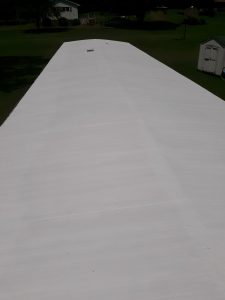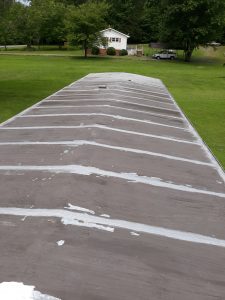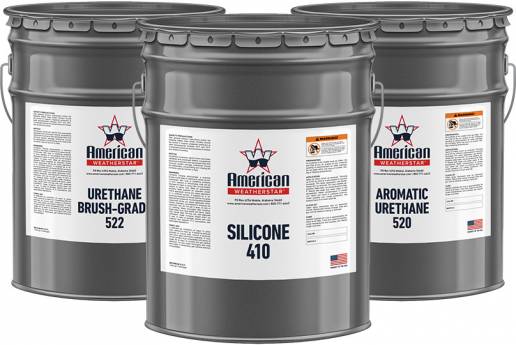Silicone Roof Coating System
Benefits, Cost, and Maintenance
Silicone roof coating system is a popular choice among building owners and facility managers due to its numerous benefits. This type of coating is made of silicone, a synthetic material that is highly resistant to weathering, UV radiation, and chemicals. It is typically applied to flat or low-sloped roofs to protect them from water damage and extend their lifespan.
![]()
One of the main advantages of silicone roof coating system is its ability to provide a seamless and waterproof barrier over the roof surface. This means that there are no seams or joints where water can penetrate and cause leaks. As a result, the building is protected from water damage and the associated costs of repairs and replacements. Additionally, silicone roof coating system can reflect sunlight and reduce the amount of heat absorbed by the building, leading to lower energy bills and a more comfortable indoor environment.
Overall, silicone roof coating system is a reliable and cost-effective solution for protecting and extending the lifespan of flat and low-sloped roofs. Its benefits include waterproofing, UV resistance, chemical resistance, and energy efficiency. By choosing silicone roof coating system, building owners and facility managers can ensure that their roofs are protected from the elements and that their buildings are more sustainable and comfortable.
Benefits of Silicone Roof Coating System
The use of silicone roof coating system has become increasingly popular in recent years due to its numerous benefits. In this section, we will discuss some of the benefits of this system.
Increased Durability
 One of the main benefits of silicone roof coating system is its increased durability. This coating is highly resistant to weathering, UV radiation, and other environmental factors that can cause damage to a roof. As a result, it can extend the lifespan of a roof by up to 20 years or more. Additionally, silicone roof coating is highly flexible and can expand and contract with changes in temperature, which reduces the likelihood of cracking or splitting.
One of the main benefits of silicone roof coating system is its increased durability. This coating is highly resistant to weathering, UV radiation, and other environmental factors that can cause damage to a roof. As a result, it can extend the lifespan of a roof by up to 20 years or more. Additionally, silicone roof coating is highly flexible and can expand and contract with changes in temperature, which reduces the likelihood of cracking or splitting.
Energy Efficiency
Another benefit of silicone roof coating system is its energy efficiency. This coating has high reflectivity, which means it can reflect up to 90% of the sun’s rays. This reduces the amount of heat absorbed by the roof, which in turn reduces the amount of energy needed to cool the building. This can lead to significant cost savings on energy bills over time.
Cost-Effective
Silicone roof coating system is also cost-effective in the long run. While the initial cost of installation may be higher than other roofing systems, the extended lifespan and energy efficiency of the coating can result in significant cost savings over time. Additionally, the coating requires minimal maintenance and can be easily repaired if damaged, which further reduces long-term costs.
In conclusion, the benefits of silicone roof coating system include increased durability, energy efficiency, and cost-effectiveness. These benefits make it an attractive option for those looking to improve the lifespan and energy efficiency of their roofs.
Application Process
Surface Preparation
Before applying the silicone roof coating system, it is essential to prepare the surface properly. The surface should be clean, dry, and free from any debris or loose materials. Any existing coating or rust should be removed, and the surface should be sanded to create a rough surface for better adhesion. Any cracks or gaps should be filled with a suitable sealant. It is also essential to check for any potential leaks and repair them before applying the coating.
Primer Application

Once the surface is prepared, the primer should be applied. The primer helps to improve adhesion and provides a smooth surface for the topcoat. The primer should be applied evenly using a brush, roller, or spray. It is essential to follow the manufacturer’s instructions for the application of the primer, including the recommended temperature and humidity levels.
Top Coat Application
After the primer has dried, the topcoat can be applied. The topcoat should also be applied evenly using a brush, roller, or spray. It is essential to follow the manufacturer’s instructions for the application of the topcoat, including the recommended temperature and humidity levels. It is also recommended to apply two coats of the topcoat to ensure maximum protection.
Overall, the application process of the silicone roof coating system is relatively straightforward, but it is crucial to follow the manufacturer’s instructions carefully to ensure maximum protection and longevity. It is also recommended to hire a professional contractor to apply the coating system, as they have the necessary experience and equipment to ensure a proper application.

